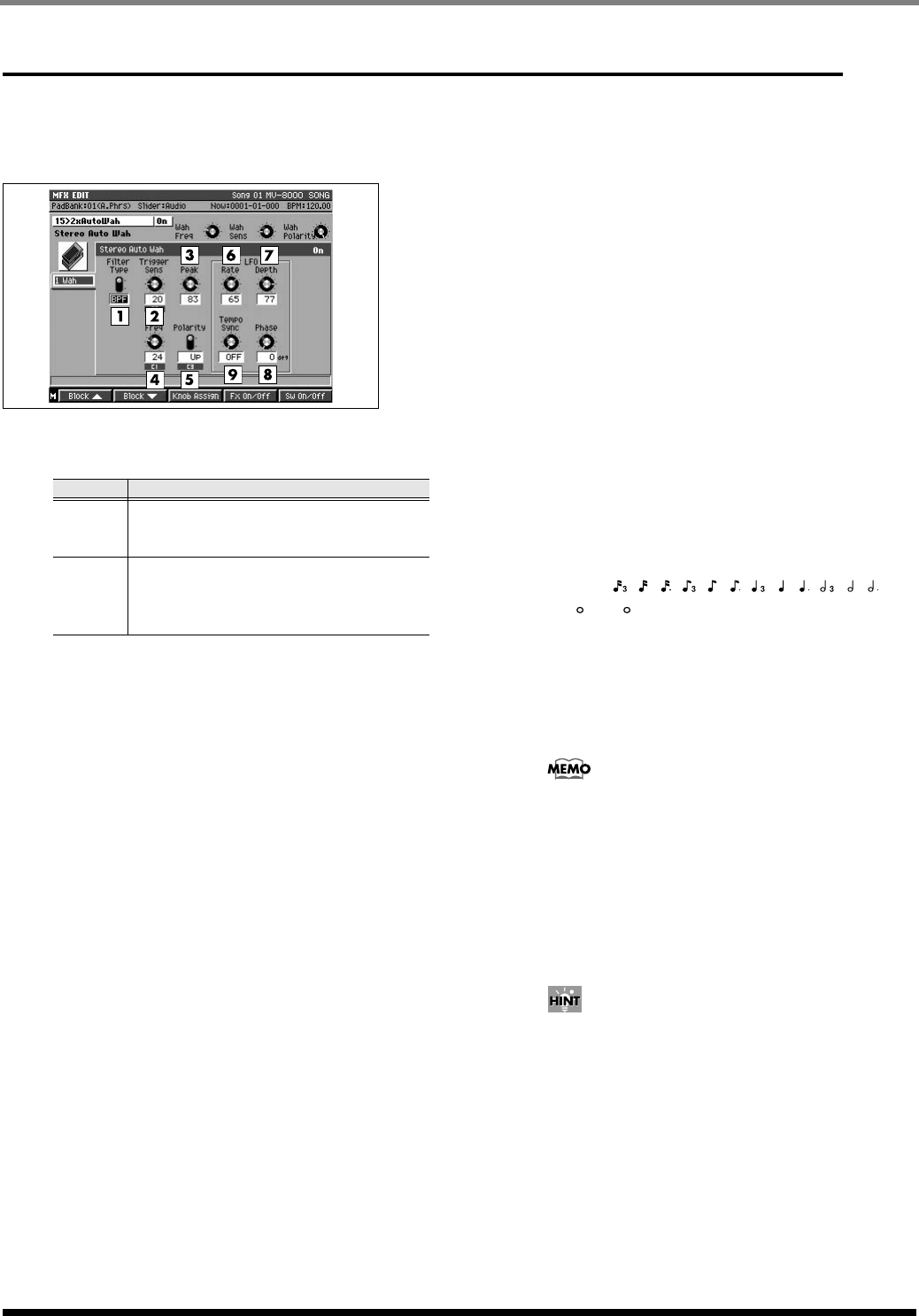
420
Effect Block
15 Stereo Auto Wah
Wah (Stereo auto wah)
This algorithm features two auto wahs arranged in
parallel, making it stereo compatible.
1.
Filter Type
Sets the type of filter used to make the wah.
2.
Trigger Sens
Value: 0–100
Sets the sensitivity level when wah is added through
changes in the source sound volume. The wah effect
is added at lower volumes as the value increases.
3.
Peak
Value: 0–100
Sets the degree of the wah effect near the reference
frequency. The range narrows as the value increases;
as you lower the value, you get the wah effect over a
wider range.
4.
Freq
Value: 0–100
Sets the reference frequency for the wah effect. The
higher the value is set, the higher the frequency is.
5.
Polarity
Value: DOWN, UP
When applying the wah effect through changes in the
source sound volume, this setting is for selecting
whether the effect is to be in the high frequencies
(UP) or lower frequencies (DOWN).
6.
LFO Rate
Value: 0–100
Sets the rate of the periodic wah sound. During
Tempo Sync, this is disabled, and you cannot make
this setting.
7.
LFO Depth
Value: 0–100
Sets the depth of periodic the wah sound.
8.
LFO Phase
Value: 0–180deg
This shifts the phase of the Low Frequency Oscillator
(LFO) that produces the opening/closing cycle of the
stereo wah. You can change the timing of the cyclic
wah effects in the left and right channels. At “0deg”
(0 degrees), the wah effects of left and right open and
close together. At 180 degrees, they are completely
opposite.
9.
Tempo Sync
Value: OFF, , , , , , , , , , , , ,
x1 – x4
Set this when synchronizing the LFO Rate setting to
the song tempo. When not synchronizing, set this
“OFF.” When you select the note, the LFO Rate
setting is disabled, and the LFO Rate is set the note
length corresponding to the song tempo.
If the length of the note is set longer (or shorter)
than that of the possible range of the Rate settings
by the change of song tempo, the Rate can not
correspond to the note length. If “?” appears before
the note symbol you set, it is because the upper (or
lower) limit of the setting range has been exceeded,
and that the synchronization is not correct.
Furthermore, the precision of the Rate setting and
song tempo differ. If left to develop over long
periods, the two may gradually drift apart.
When you want only to get a periodic wah sound
from the LFO, set Trigger Sens to 0. Conversely, if
you want the wah effect to reflect the source sound,
set the LFO depth to 0. When both are set to 0, you
can use the C (Control) knob to change the
frequency, and get the “manual wah” (pedal wah)
effect.
Value
Explanation
LPF
(Low pass filter) Passes frequencies be-
low the cutoff frequency. This allows
wah over a wide range of frequencies.
BPF
(Band pass filter) Passes frequencies
near the cutoff (center) frequency. This
lets you keep the wah within a narrow
range.
ECS05_manual_e.book 420 ページ 2005年11月30日 水曜日 午前11時14分


















